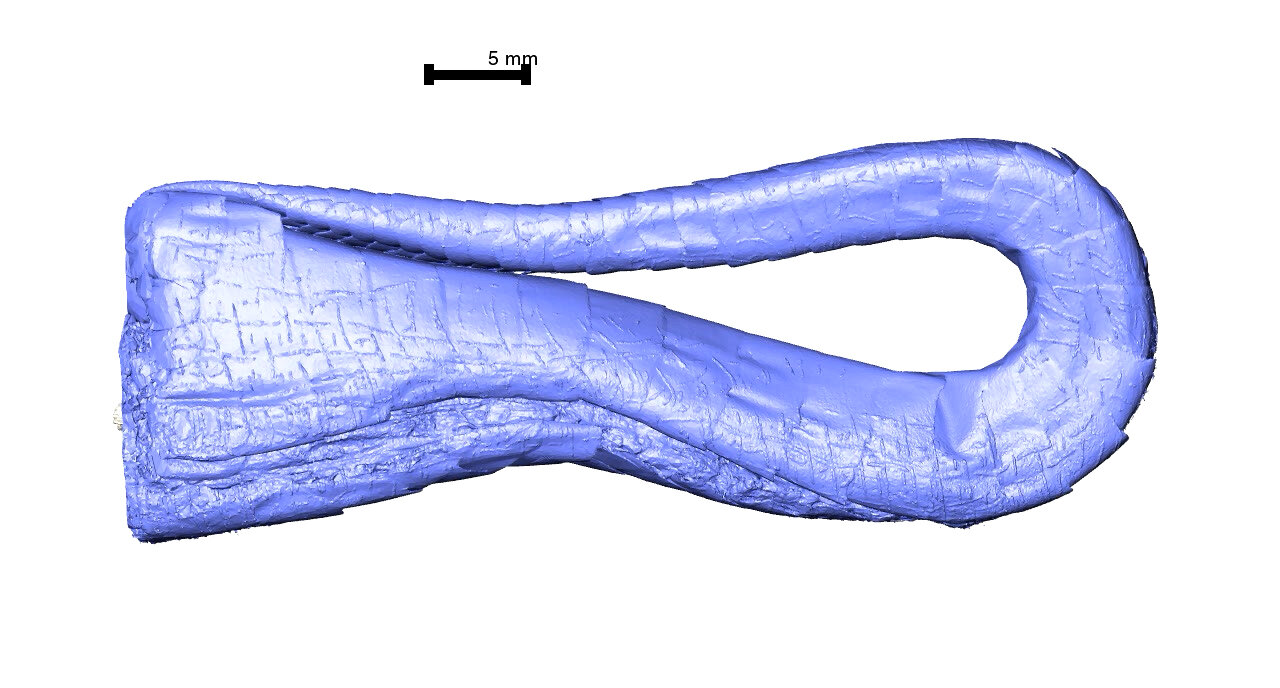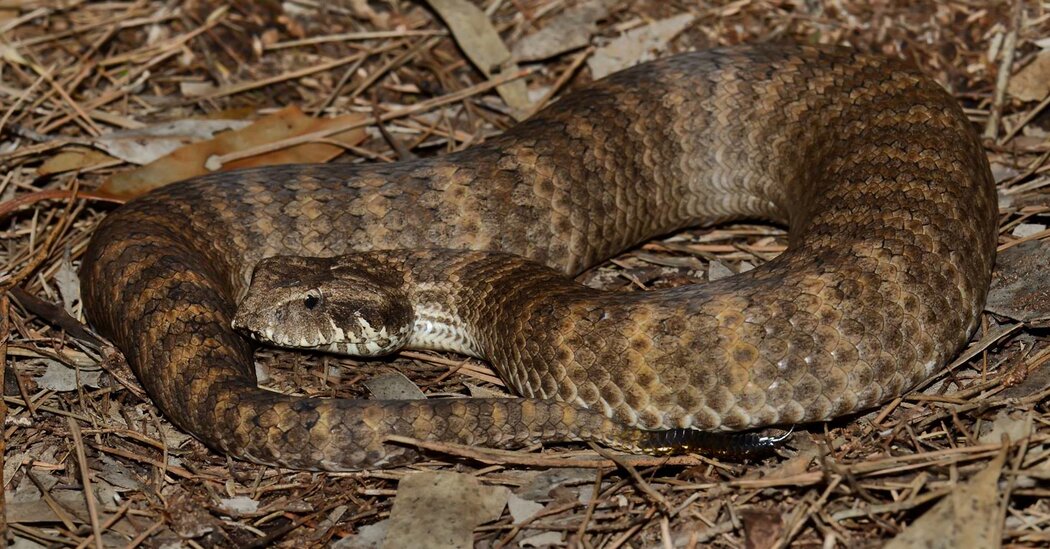You’ve probably seen a snake’s forked tongue, but it’s not the slithering animal’s only forked body part. Male snakes sport forked genitals called hemipenes that look a bit like pink cactuses and often have spines to match.
What’s good enough for him is good enough for her in the suborder Serpentes. In a paper published Wednesday in the Proceedings of the Royal Society B, scientists provide the first proper scientific description of the hemiclitores, or a bifurcated clitoris in female snakes. The study also challenges a longstanding bias in biology — linked to cultural attitudes and a dearth of women in the field — that has left female sexual anatomy woefully understudied in many species.
Not only do snakes have hemiclitores, the study’s authors report, but the organs also contain nerves and erectile tissue, suggesting they serve a reproductive function and are not merely vestigial.
If subsequent research confirms the presence of a functional clitoris, it could challenge the assumption that snake sex is coercive.
Advertisement
Continue reading the main story
“Now we can consider whether mating in snakes is not about coercion but instead about stimulation and seduction,” said Megan Folwell, a doctoral candidate at the University of Adelaide in Australia and an author of the study. “Maybe there is something the males are doing that makes the females more inclined to participate.”
Ms. Folwell’s study of the hemiclitores began when she noticed there were reams of publications describing the many shapes and sizes of snake hemipenes, but only scant mentions of female sex organs. That includes the clitoris, a structure present in all mammals, all lizards and some birds. The few papers she did find either offered no anatomical description or provided incorrect ones.
Video

A 3-D model of the female death adder’s hemiclitores.CreditCredit...Megan Folwell/Proceedings of the Royal Society B
To investigate, Ms. Folwell set about dissecting the tail of a female death adder. Once she cleared away the muscle and connective tissue covering the snake’s genitals, the hemiclitores stared her in the face.
When Ms. Folwell showed her findings to Patricia Brennan, who studies genital morphology at Mount Holyoke College and is a co-author of the paper, Dr. Brennan said the find was so shockingly obvious that she almost fell out of her chair.
Advertisement
Continue reading the main story
To confirm their initial observations and learn more, the researchers used multiple techniques to examine the anatomy of eight other species of snakes from four families.
Together, these analyses established the snake hemiclitores’ bona fides.
“I had never heard of snake hemiclitores, but it’s completely logical that they would be there and even be functional,” said Kurt Schwenk, a herpetologist at the University of Connecticut who didn’t participate in the research.
Ms. Folwell and her co-authors also encountered substantial variation in size and shape among the nine species tested, with the cantil viper having the largest hemiclitores at 1.2 inches long and 0.7 inches wide and the Guatemalan milk snake at just 0.1 inches long and 0.06 inches wide.
“If the hemiclitores were nonfunctional then there is no evolutionary reason for them to be different across species,” Dr. Brennan said.
Marvalee Wake, an evolutionary morphologist at the University of California, Berkeley, who was not involved in the study, said the inference that the hemiclitores were functional seemed reasonable but added that “now they have to demonstrate it experimentally.”
Ms. Folwell said the next steps for this research would include investigating the types and locations of nerves present in the hemiclitores and then trying to establish what roles the structures may play during mating. Many snakes engage in sensual-looking courtship behaviors such as wrapping and rubbing their tails together.



Continue reading the main story
Advertisement
Continue reading the main story
“This discovery could really change how we understand mating in snakes,” Dr. Brennan said, “and it just shows how much we’ve been missing by largely ignoring female anatomy.”

Half the World Has a Clitoris. Why Don’t Doctors Study It?
The organ is “completely ignored by pretty much everyone,” medical experts say, and that omission can be devastating to women’s sexual health.
Oct. 17, 2022
Even in other groups of animals where the existence of a clitoris is not in question, such as lizards, investigations of its function have been hemmed in by cultural attitudes.
“Darwin described females as coy and passive participants in sexual selection,” said Malin Ah-King, an evolutionary biologist and gender researcher at Stockholm Univesity in Sweden who was not involved in the study. “These Victorian gender notions influenced Darwin and have been with us in evolutionary biology ever since.”
In an extreme example of a male-centric point of view, Dr. Brennan said one study of lizard hemiclitores went so far as to suggest their function might be to stimulate the male during mating.
“Now that more researchers are exploring the female side of things we get to know more of the details of what’s really there,” Dr. Ah-King said. “Each person’s perspective has limits, and this research shows how bringing in more perspectives can give us a more complete picture.”

 www.nytimes.com
www.nytimes.com
What’s good enough for him is good enough for her in the suborder Serpentes. In a paper published Wednesday in the Proceedings of the Royal Society B, scientists provide the first proper scientific description of the hemiclitores, or a bifurcated clitoris in female snakes. The study also challenges a longstanding bias in biology — linked to cultural attitudes and a dearth of women in the field — that has left female sexual anatomy woefully understudied in many species.
Not only do snakes have hemiclitores, the study’s authors report, but the organs also contain nerves and erectile tissue, suggesting they serve a reproductive function and are not merely vestigial.
If subsequent research confirms the presence of a functional clitoris, it could challenge the assumption that snake sex is coercive.
Advertisement
Continue reading the main story
“Now we can consider whether mating in snakes is not about coercion but instead about stimulation and seduction,” said Megan Folwell, a doctoral candidate at the University of Adelaide in Australia and an author of the study. “Maybe there is something the males are doing that makes the females more inclined to participate.”
Ms. Folwell’s study of the hemiclitores began when she noticed there were reams of publications describing the many shapes and sizes of snake hemipenes, but only scant mentions of female sex organs. That includes the clitoris, a structure present in all mammals, all lizards and some birds. The few papers she did find either offered no anatomical description or provided incorrect ones.
Video

A 3-D model of the female death adder’s hemiclitores.CreditCredit...Megan Folwell/Proceedings of the Royal Society B
To investigate, Ms. Folwell set about dissecting the tail of a female death adder. Once she cleared away the muscle and connective tissue covering the snake’s genitals, the hemiclitores stared her in the face.
When Ms. Folwell showed her findings to Patricia Brennan, who studies genital morphology at Mount Holyoke College and is a co-author of the paper, Dr. Brennan said the find was so shockingly obvious that she almost fell out of her chair.
Advertisement
Continue reading the main story
To confirm their initial observations and learn more, the researchers used multiple techniques to examine the anatomy of eight other species of snakes from four families.
Together, these analyses established the snake hemiclitores’ bona fides.
“I had never heard of snake hemiclitores, but it’s completely logical that they would be there and even be functional,” said Kurt Schwenk, a herpetologist at the University of Connecticut who didn’t participate in the research.
Ms. Folwell and her co-authors also encountered substantial variation in size and shape among the nine species tested, with the cantil viper having the largest hemiclitores at 1.2 inches long and 0.7 inches wide and the Guatemalan milk snake at just 0.1 inches long and 0.06 inches wide.
“If the hemiclitores were nonfunctional then there is no evolutionary reason for them to be different across species,” Dr. Brennan said.
Marvalee Wake, an evolutionary morphologist at the University of California, Berkeley, who was not involved in the study, said the inference that the hemiclitores were functional seemed reasonable but added that “now they have to demonstrate it experimentally.”
Ms. Folwell said the next steps for this research would include investigating the types and locations of nerves present in the hemiclitores and then trying to establish what roles the structures may play during mating. Many snakes engage in sensual-looking courtship behaviors such as wrapping and rubbing their tails together.
Editors’ Picks

Our 20 Most Popular Recipes of 2022

Why Do Men Sprout Hairs in Weird Places With Age?

Fusion? We’ve Seen This Movie Before.
Continue reading the main story
Advertisement
Continue reading the main story
“This discovery could really change how we understand mating in snakes,” Dr. Brennan said, “and it just shows how much we’ve been missing by largely ignoring female anatomy.”

Half the World Has a Clitoris. Why Don’t Doctors Study It?
The organ is “completely ignored by pretty much everyone,” medical experts say, and that omission can be devastating to women’s sexual health.
Oct. 17, 2022
Even in other groups of animals where the existence of a clitoris is not in question, such as lizards, investigations of its function have been hemmed in by cultural attitudes.
“Darwin described females as coy and passive participants in sexual selection,” said Malin Ah-King, an evolutionary biologist and gender researcher at Stockholm Univesity in Sweden who was not involved in the study. “These Victorian gender notions influenced Darwin and have been with us in evolutionary biology ever since.”
In an extreme example of a male-centric point of view, Dr. Brennan said one study of lizard hemiclitores went so far as to suggest their function might be to stimulate the male during mating.
“Now that more researchers are exploring the female side of things we get to know more of the details of what’s really there,” Dr. Ah-King said. “Each person’s perspective has limits, and this research shows how bringing in more perspectives can give us a more complete picture.”

Scientists Overlooked the Snake Clitoris, Until Now
Missed for decades, this anatomical revelation opens the door to seduction and female stimulation potentially playing roles in snake mating.
